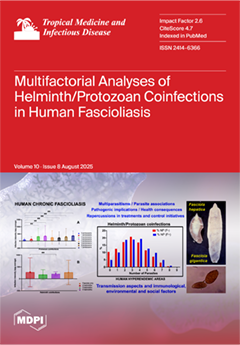Research is required to determine whether the coinfections by
Fasciola spp. and other parasite species result from poor rural hygiene or reflect underlying epidemiological patterns and causes. Therefore, the role of fascioliasis is analyzed concerning coinfection complexity, risk of multiparasitism, parasite associations, pathogenic
[...] Read more.
Research is required to determine whether the coinfections by
Fasciola spp. and other parasite species result from poor rural hygiene or reflect underlying epidemiological patterns and causes. Therefore, the role of fascioliasis is analyzed concerning coinfection complexity, risk of multiparasitism, parasite associations, pathogenic implications and their multifactorial causes. Helminth and protozoan coinfections are studied in 2575 previously untreated individuals from four rural hyperendemic areas (Northern Bolivian Altiplano, Peruvian Altiplano and Cajamarca valley, and the Egyptian Nile Delta). This cross-sectional study was conducted from January 2011 to December 2023. Coinfections were coprologically assessed by the merthiolate–iodine–formalin and formol–ether concentration techniques. Infection intensity was measured as eggs/gram of feces (epg) with the Kato–Katz technique. Parasite and coinfection prevalences were stratified by age, sex and geographical location. High mixed infections, fascioliasis prevalences and very low non-coinfected
Fasciola-infected subjects were associated with the following regions: Bolivian Altiplano, 96.5%, 16.8% and 3.5%; Peruvian Altiplano, 100%, 24.6% and 0%; Cajamarca valley, 98.7%, 21.4% and 1.8%; Nile Delta, 84.1%, 13.0% and 15.9%. Transmission routes and human infection sources underlie fascioliasis associations with protozoan and other helminth infections. Prevalence pattern of protozoan–helminth coinfections differed between
Fasciola-infected individuals and individuals not infected with
Fasciola, presenting higher prevalences in individuals with fascioliasis. Multiparasitism diagnosed in
Fasciola-infected subjects included coinfections by up to nine parasite species, eight protozoan species, and five helminth species. The most prevalent pathogenic protozoan was
Giardia intestinalis. The most prevalent helminth species differ according to environmental conditions. Several parasites indicate fecal environmental contamination. When the fascioliasis burden increases, the total number of parasite species also increases. The fascioliasis risk increases when the total helminth species number/host increases.
Fasciola-infected subjects may present a modification in the clinical phenotypes of coinfecting parasitic diseases. Fascioliasis coinfection factors include transmission ways and immunological, environmental and social aspects. Coinfections must be considered when assessing the health impact of fascioliasis, including the analysis of the fascioliasis effects on malnutrition and physical/intellectual child development. Fascioliasis-control schemes should, therefore, integrate control measures mainly against other helminthiases.
Full article






